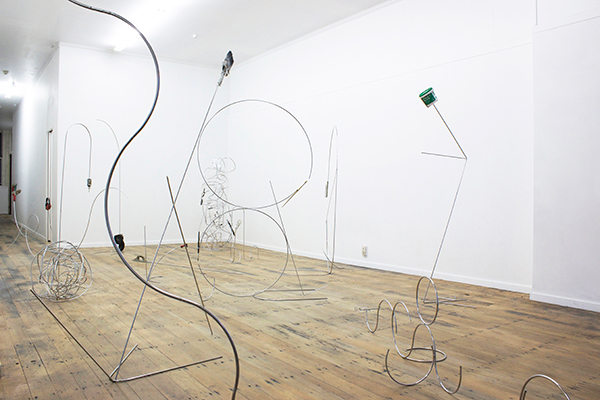Yona Lee - Specific Objects
Exhibited until Saturday 26 July
Yona Lee is a Korean-born artist (and former cellist) currently residing and working in Onehunga, Auckland. She acquired an MFA from Elam School of Fine Arts in 2010, leading to her most recent exhibitions including Tangential Structures, Enjoy Public Art Gallery, Wellington (2013); Line Works, Art Space, Auckland (2012); Composition, Te-Tuhi Centre for the Arts, Auckland (2012); and Constrained Organism, Open Window and Govett-Brewster Art Gallery, New Plymouth (2011).
On the objects she chooses to display in her sculptural forms, Lee writes:
“I am interested in the things that are usually hidden, and things that are not a subject matter but rather a supporter. These banal objects or tools are humble in that they don’t demand other’s attention of their existence. My desire is for these hidden objects to receive the same amount of focus as the work itself and reveal their hidden beauty. Their humble existence is beautiful.”
We can see in Specific Objects how Lee has used every day objects, such as paintbrushes, scissors and earmuffs, to draw attention to the changing role of such objects in the post-industrial world. Each object hangs from various rods of steel that erect from the heart of each sculpture, like withered fruit hanging off dead twigs.
Lee’s use of steel is appropriately made less aggressive and definitive by its curvy construction, displaying Lee’s interest in the utilisation of industrial materials in the modern world, and the objects attached to various parts of the rods (as aforementioned) suggest the shift from a industrial/labour driven economy, to the creative/capital-culture economy that we currently find ourselves living in.
While still in conversation with minimalism and formalism, stylistically, Specific Objects does divert both aesthetically and conceptually from previous exhibitions.
In Composition (2012), Lee’s artistic enquiry melds the formalism of classical music with an exploration of space and industrial materials, reminiscent of 1960s minimalism. Through this work, Lee enters into a conversation with the legacy of minimalist artists such as Sol Le Witt and Fred Sandback. Her reference to classical music, however, derails this association to problematically introduce sentiment within the piety of formalism.
In Specific Objects, the shown objects and steel structures stand more singularly superior to the space in which they are being shown. Lee has used a machine that bends steel using different sized discs. Lee compares her engineering of the rods to playing the cello, saying:
“You have a limitation of sound that you can produce, but within that you do have a lot to work with.”
Lee takes her exhibition title from Donald Judd’s seminal minimalist text written in 1965, in which he passionately espouses his views on the use and effects of industrial materials in sculpture. In this text Judd wrote:
“Formica, aluminium, cold-rolled steel, Plexiglas, red and common brass, and so forth. They are specific. If they are used directly, they are more specific. Also, they are usually aggressive. There is objectivity to the obdurate identity of a material.”
Lee’s evocation of this text traces the shift in ideology around the material object. Here Judd’s notion of the “specific object” (one, seemingly of pure form and objective materiality) becomes a counterpoint to contemporary conceptions of the material object as amorphous—as continually constituted by the slow warp of cultural thought.
In Specific Objects, through Lee’s meticulously measured, cut and welded rods of steel, combined with the lingering presence of mass-manufactured objects, Lee draws attention to the dramatic shift in the ecology of the object as its identity changes with the rise of the immaterial, post-industrial phenomena. Lee ultimately makes a metal mockery out of millennial materialism and it is banal brilliance.
Stylistically fresh, and on for another week, this exhibition is not one to be missed.



